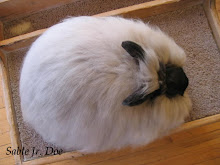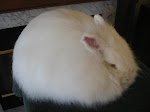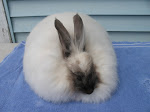--Another post from the old blog:
Here are some interesting excerpts from an article I found on Handling and Posing rabbits in the ARBA Handbook (pg. 35), written by Joey E. Shults. Joey writes:
"Proper handling technique is very important for the safety of not only the rabbit, but the handler as well. Before we begin, I would recommend the beginner should wear long sleeves for added protection. First and foremost, remember that you do not handle the rabbit in a rough or careless manner---rabbits have feelings, too".
"How do you safely take a rabbit out of its cage? To remove a rabbit from its coop (cage), if you are right-handed, put your left arm in the coop. Place your left hand palm down over the rabbit's shoulder with your thumb in front of the ears. Gently cup your hand around the shoulders and squeeze your thumb against your index finger, grasping the rabbit to the point that you feel you have control of the rabbit. Then put your right hand in the coop underneath the rabbit's belly, lifting the rabbit to the cage door".
"It is very important to lift rather than drag the rabbit toward you, so as not to pull or break the rabbit's toenails on the wire."
A few paragraphs down Shults goes on to say, "When placing a rabbit back in its coop, use the same procedure, being sure to place rabbit back in cage tail end first".
At shows, in particular, I have noticed that people have many different ways of handling their rabbits:). Joey Shults advocates removing them from the cage head first, but other breeders prefer removing them tail first, and placing them back in the same way. The head first method is fine as long as you make certain to LIFT the animal at the same time to avoid ripped out toenails, but never grab the skin over the shoulders and drag a rabbit forward under any circumstances:(. At home in my own barn, I almost always take bunnies out of their cages rear-end first. I turn them so that their backs are facing me, and place one hand underneath the chest and the other directly under the hindquarter to lift them straight up and out. When removing rabbits from upper level cages it is a good idea to use a stepstool so that you are at an even level with the cage door. If you remove a rabbit tail-end first there tends to be less chance of getting bitten or scratched since you are not approaching the rabbit head on and they perceive you as less of a threat, but DO always remember to speak as you approach so they are all aware that you're coming.
Shults also gives excellent advice about posing in the same article (pg. 36). He says,
"Posing, by definition, is to "strike an effect", or in this case to put a rabbit in a comfortable position so one can determine conformation and bone structure. To pose the rabbit, place the rabbit on the table and put the tip of the front feet even with the eyes and the tip of the rear feet even with the hip bone. The hipbone is the bulge of the thigh on the rabbit's side while in the sitting position. Be sure that the rabbit's tail is showing and not tucked underneath the body. The rabbit should be allowed to assume a comfortable pose, but should remain still for close scrutiny".
"Many rabbits have been beaten at a show, not for lack of type, but for lack of being able to show off that type to the judge, or pose. The rabbit should never be poked rudely, or pushed down during the posing. Remember, the properly handled and posed rabbit is not only a joy to behold, but a joy to handle as well."
Even with a breed such as the Angora, the importance of posing cannot be underestimated. When I attended the Convention in IN last year, the posing ability of the animals on the BIS table was nothing short of remarkable, and I am certain that it had at least something to do with their excellent placements. If a well-typed bunny can freeze on the showtable long enough for the judge to get a look at it from all angles, it certainly has a chance to do well, or at least get a more accurate evaluation. Whenever you take a bunny out for grooming, set it on the table in the commercial pose and put it back into place every time it moves for approx. 5 min. If you repeat this exercise often enough you will eventually have a rabbit who poses automatically whenever it is placed on a table, and you will have a better chance of showing your bunnies to their best advantage.
Monday, June 1, 2009
Subscribe to:
Post Comments (Atom)























No comments:
Post a Comment